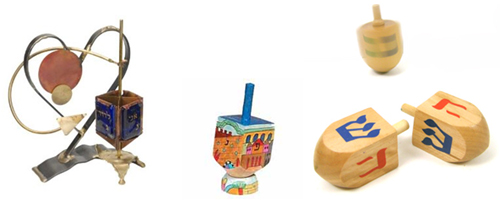
The driedel game, a popular Hanukah activity for children, grew into an adult passion for my mother (Eva Weinstein; Hebrew name Chava חוה, which means “life”), as she collected another and another and another and…until there was a glass-enclosed cabinet full of dreidels, each with a unique story about how and why it was acquired. They ranged from the silly (of the wind-up and walk plastic variety) to the delicious (chocolate ones, only 1 of which has survived the years – well-wrapped in plastic wrap of course!) to true works of art (http://tinyurl.com/GaryRdreidels).
When there is a family member with a “collection” it becomes relatively easy to purchase gifts, as the preferences are well-established. Therefore, the dreidel collection grew exponentially each birthday, Hanukah, anniversary and every other gift-giving occasion. But their value is more sentimental than financial. Memories create meaning; looking at them (or even playing the occasional dreidel game using them) is a reminder of happy times. For example, several were acquired at the gift shop of the Spertus Institute of Judaica in Chicago (http://shop.spertus.edu). We were fortunate to live a short South Shore electric train ride away, and an excursion there was always an adventure; one time even including splurging for lunch at the historic Walnut Room on State Street. (http://tinyurl.com/walnutroom). Another memory is saving up enough money to buy my mom a crystal dreidel. I had been living away from home and didn’t know she had already acquired a few similar styles. No worries; she placed it next to the handmade dreidel I had given her almost 2 decades earlier and started a mini-collection of “Faigel (my Yiddish name) dreidels.”
My mom died in April 2012. She had acquired many collections…music boxes, paperweights, Lladros… all beautiful, but none with as much meaning for me as those dreidels. Special thanks to Indiana University East curator Ed Thornburg and library assistant Jesse Whitton for their help with the exhibit. I am pleased and honored to share some of Chava’s dreidels with you during this Chanukah season.
Info. about dreidels and Hanukah: http://iue.libguides.com/dreidels

A dreidel (Yiddish דרײדל dreydl, Hebrew: סביבון sevivon) is a four-sided spinning top with which to play a game of chance during the 8 days of the Jewish holiday of Hanukah. Each side of the dreidel bears a letter of the Hebrew alphabet: נ (Nun), ג (Gimel), ה (Hei), ש (Shin), which together form the acronym for “נס גדול היה שם” (Nes Gadol Hayah Sham – “a great miracle happened there”). These letters also form a mnemonic for the rules of the dreidel game:
Nun represents the Yiddish word nisht (“nothing”), Hei for halb (“half”), Gimel for gants (“all”), and Shin for shtel ayn (“put in”). In Israel, the fourth side of most dreidels is inscribed with the letter פ (Pei), which alters the acronym to נס גדול היה פה, Nes Gadol Hayah Poh—”A great miracle happened here” referring to the miracle occurring in the land of Israel.
The Yiddish word “dreydl” comes from the word “dreyen” which means “to turn” (and can be compared to the German “drehen”, as Yiddish is derived from that language). The Hebrew word “sevivon” also means “to turn.”
To play the driedel game, each participant begins with an equal number of game pieces (usually 10–15). The game pieces can be any object, such as candies, pennies, or nuts in a shell. At the beginning of each round, every player puts one game piece into the center “pot” and must contribute one game peice every time the pot is empty. Each player spins the dreidel once during their turn. Depending on which dreidel side is facing up when it stops spinning, the the player gives or takes game pieces from the pot:
a) If נ (nun) is facing up, the player does nothing.
b) If ג (gimel) is facing up, the player gets everything in the pot.
c) If ה (hei) is facing up, the player gets half of the pieces in the pot. (If there are an odd number of pieces in the pot, the player takes the half the pot rounded up to the nearest whole number)
d) If ש (shin) or פ (pei) is facing up, the player adds a game piece to the pot. In some game versions a Shin results in adding three game pieces to the pot (one for each stem of the Shin).
When a player is out of game pieces, he or she is either “out” or may ask another player for a “loan.”
Plastic or wooden driedels are inexpensive and available online or in most large stores in November and December. But if you don’t happen to have one, you can always play a virtual dreidel game: http://www.jewfaq.org/dreidel/index.htm. An interpretation of the history of the game is provided at the Chabad organization’s website. http://www.chabad.org/library/howto/wizard_cdo/aid/597255/jewish/The-History.htm

